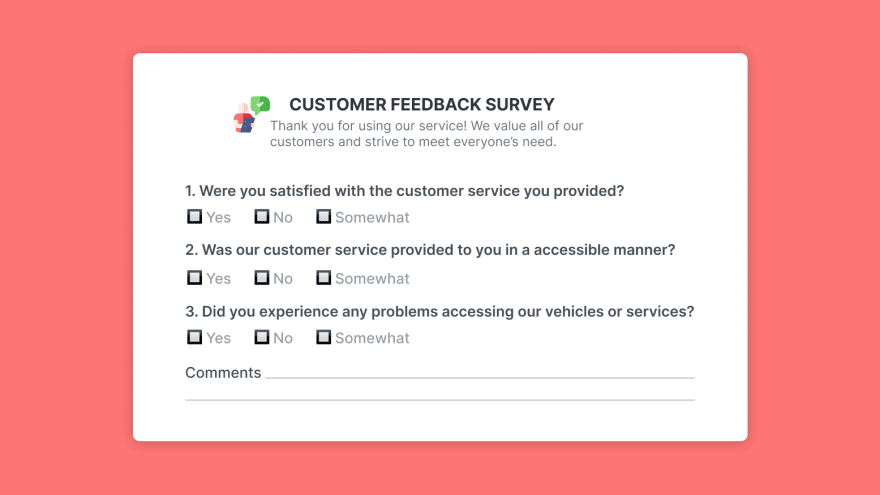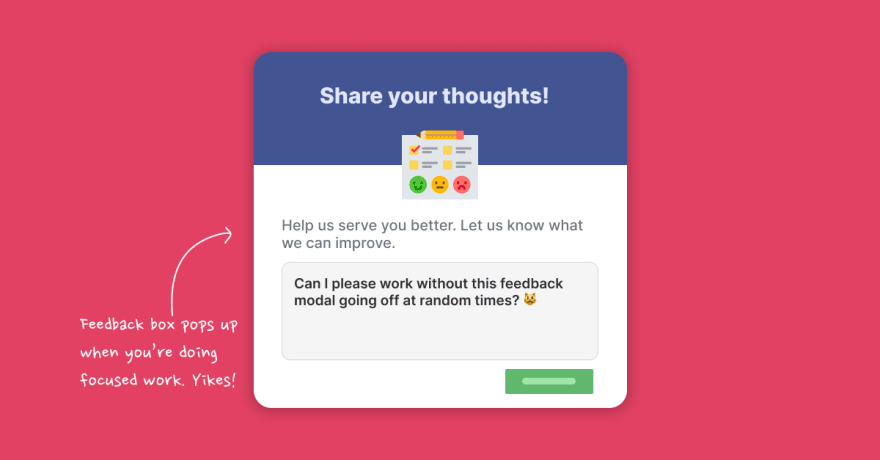Customer feedback matters. It's at the core of every successful company. Feedback captures the expectations, likes, and dislikes of your customers. To build a strong relationship with their customers, companies must listen to what they have to say, act on it, and close the feedback loop by notifying them.
Although customers nowadays are far more vocal and forthcoming, you'd still have to put in a lot of work to capture their thoughts and ideas because they're not so keen on contributing back.
Here's some of the reasons why customers loathe the idea of giving product feedback:
Customers don't hear back
When a customer reaches out, how long does it take for you to reply? Are you making your customers feel appreciated? Do they feel good about your product?
Whenever you ask customers for feedback, listen even if it is negative. Listening and responding plays a crucial role in customer satisfaction and customer retention.
Customers would be enthusiastic about providing feedback if they see it making a difference. Ignoring feedback, responding slowly, or not involving customers at all in a product's roadmap would be the ultimate recipe for failure. There's no point in asking for customer feedback if you don't plan to address it.
Customers desire transparency and action. When you don't pay heed to their suggestions, they often feel like you're turning a deaf ear. They feel abandoned & unheard, and feel wary of providing any feedback in the future. And to put salt on the wound, your customers might jump ship if they can.
Feedback surveys are too long
Taking long feedback surveys is a pain; you wouldn't want your customers to go through. A study found that 60% of users don't want to take a survey that takes longer than 10 minutes. Narrow your focus while taking surveys.
Understanding your customer's persona when collecting feedback is vital to make informed decisions about the number and type of questions in the survey. Different customers can have different motivations for providing feedback with varying attention spans and tolerance for lengthy surveys.
People are busy. The more questions you ask, the less time they would spend answering each question, giving you incoherent answers. Customers like nothing less than a long and drawn-out survey, which they won't even complete or will provide random answers to get it over the finish line.
Emails are too messy
Email is probably the best channel for soliciting customer feedback and also the messiest. Since email is the best channel for marketing, there is a high chance that your email is going to be marked as spam.
Even if it goes through, most feedback-seeking emails sound so formal, joyless, and automated that the intended recipient rarely hits the reply button. On top of that, managing emails is a nightmare.
Customers appreciate companies that care but sending a feedback email with a "Feel free to let me know what do you think?" definitely doesn't scream customer engagement.
It is easier to overlook collecting and analyzing customer feedback, but it is vital to understand customers' needs. Collecting feedback via emails feels like you could do with or without their feedback; why would they even bother to reply then?
Live chats are not for feedback
Chats are used to enhance customers' experience and clarify their doubts whenever they are stuck somewhere, not to collect their feature requests or any product related insights.
Chats answer customers' queries on the spot, making them essential for customer support and satisfaction. Live chat is an excellent real-time interaction tool but horrendous for collecting feedback.
Keeping track of which customer asked what, becomes extremely hard with chats and becomes unmanageable in the case of duplicate entries and requests. That's the #1 reason which makes customers hesitant to request anything on chat.
Along with that, chats take up valuable time to simultaneously collect feedback and troubleshoot any problems, making this process cumbersome.
Product Feedback boxes and pop-ups are annoying
Feedback pop-ups that emerge out of nowhere, asking unrelated questions are nothing but a big turn off. It annoys the customer and they might end up leaving your site altogether.
Poorly designed feedback boxes and pop-ups with lots of questions might even get on the nerve of those customers who want to give positive feedback. An intricate feedback pop-up design makes providing feedback hard.
Think of the experience you're subjecting your customers to. They open the app to get things done, and you show them the feedback pop-ups -- which go off and on again and again –– interrupting their whole flow.
Simple, intuitive UI with minimal complexity is practical and more comfortable to attract great feedback.
Using social media for feedback isn't feasible and too transparent
Social media feedback isn't targeted and is public, so it's instantly visible to almost everyone. It's hard to discover and most of the times gets lost.
It requires staff-hours for searching either with a hashtag or keywords to identify those specific comments relevant to your product, making it a super complicated job.
It is a very labor-intensive and time-consuming job to manage feedback from different social media accounts and requires dedicated resources. Social media makes it even harder to follow-up with the customer to address any issue, leaving them hoping for replies and in-the-end frustrated.
And also, you're right in front of everyone. Your competitors can see you reason through and say NO to building features that their potential customers want.
Summary
- Not acting on or providing progress on customer feedback is a recipe for disaster.
- Surveys are often long and drawn out. The answers you'll receive will vary in quality.
- Soliciting feedback via email feels joyless and often times automated. Customers can see through it.
- People hate pop-ups that go off at random times on an app they're paying for is infuriating.
- Live chats require logistics and additional training for your support staff.
- Social media is way too transparent, and your competitors might snoop on what you're not building to prioritize their roadmap.
Customers ♡ You
Customers love giving feedback. They like the software they pay for to keep on improving and to keep adding more useful functionality.
It's the way we collectively solicit feedback that annoys them. And probably why they hate giving feedback already.
With Rapidr, our primary goal is to help product teams like yours stay on top of the incoming feedback and truly understand what your customers want. That too without live chat, pop-ups, Slack, and god-forbid emails.
We're building a product that your customers feel joy using, where they can speak their hearts out and find what they needed but didn't know. And for you to understand how your customers use your products at a deeper level, paving way for customer-led growth.
Building customer-first products have never been so simple. Rapidr is a breath of fresh air and free to try.





Top comments (1)
Great post, Khushbu! So many pain points covered. In our company (SaaS) we also ended up with a conclusion that customers are willing to leave feedback and feature requests, and we should provide them an easy way to do it. So we created a public feedback community portal to collect and manage customer feedback (based on a tool similar to UserVoice). Plus we also publish the development roadmap to make our customers feel important and let them know that their feedback is heard and acted upon.